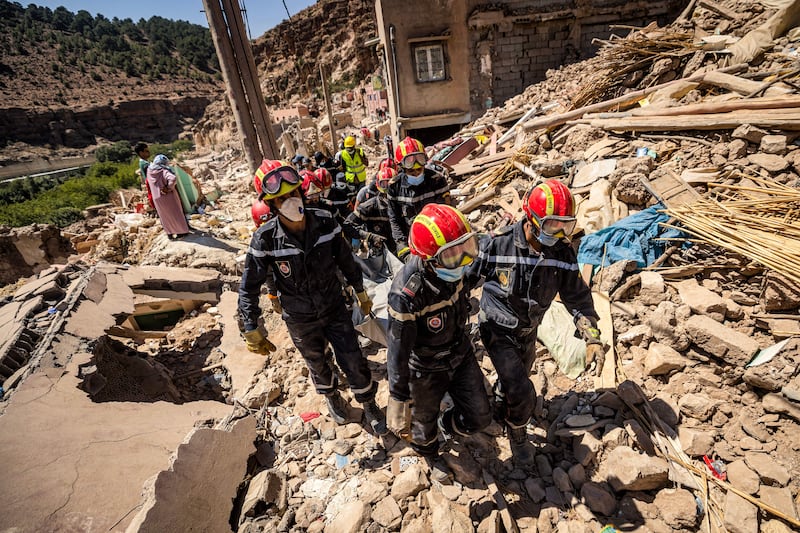Some Moroccan villagers who lost everything in last week’s earthquake were fending for themselves in the ruins of their homes on Wednesday, with roads still blocked by landslides and a dearth of essential supplies such as tents.
The 6.8 magnitude quake that struck the High Atlas Mountains late on Friday killed at least 2,901 people and injured 5,530, according to the latest official figures, making it Morocco’s deadliest since 1960 and most powerful since at least 1900.
[ Earthquake puts Morocco’s elusive king in spotlightOpens in new window ]
Morocco's army is leading relief efforts, backed by aid groups and teams sent by four other countries, but the steep, rugged terrain and damaged roads have made the response patchy, with some of the worst-hit hamlets the last to receive help.
With some survivors voicing frustration at the initially slow pace of the emergency response, King Mohammed VI on Tuesday made his first televised appearance since the quake, meeting injured people at a hospital in Marrakesh.
‘Belarus cannot be left behind’: West urged not to abandon Ukraine’s neighbour ahead of ‘sham’ election
Donald Trump’s stunning first week back in the White House shows he’s on a mission to leave a legacy
CDU leader signals radical shift on migration policy following killing of toddler
Far-right leaders freed by Trump talk of desire for retribution
Reuters reporters said there was a noticeable increase on Wednesday in the number of troops, police and relief workers near the epicentre. Tent camps were being set up or expanded, field hospitals were busy and helicopters were overhead.
Medics were dealing with broken bones, cuts and trauma injuries from falling buildings as well as treating people made homeless by the quake for chronic conditions like diabetes, though medical supplies were scarce.
At the same time, in some of the more remote locations, there was still little sign of outside help.

In the tiny village of Outaghrri, which was almost entirely flattened and where four people were killed, homeless survivors have spent the five nights since the quake sleeping outside in the schoolyard, one of few spaces not covered in rubble.
“It’s really hard. It’s cold,” said Said Ait Hssaine (27). He said survivors were fearful of aftershocks and struggling to come to terms with the deaths and destruction.
“We keep everything inside. You know people here are a little bit hard and they cannot show they are weak or they can cry, but inside you just want to go somewhere and cry,” he said.
The school itself was still standing, though with huge cracks and holes disfiguring a brightly coloured mural of coloured pencils and rendering the building unsafe. Villagers were using one of the rooms as a storage space for bottles of water and food, mostly donated by Moroccan citizens.
The village had just received a consignment of government-issued tents but they were not waterproof, a serious concern.
“Winter will come soon and it will be very difficult for people. Life was difficult here even when people lived in their houses. It snows here. Tents will not solve the problem,” said Ouazzo Naima (60) who lost eight relatives in the quake.
It was a very different scene in the large village of Asni, a transport and shopping hub for surrounding villages, where a military field hospital has been treating patients since Monday.
“This military hospital spared us a long trip. Without it we would have had to travel a long way for proper treatment,” said Brahim ait Bourhim, a resident of a nearby village. He was there with his young daughter, whose leg was injured by falling debris and who has been unable to walk since the earthquake.
Alongside the hospital were rows of large blue and green tents provided by the government for displaced people. Among the tents, children were bouncing on a trampoline.
In Talat N'Yaaqoub, a small town that suffered extensive damage but has also turned into an aid hub, patients were being treated in the back of ambulances parked in a long row alongside a tent camp for survivors.
A private initiative, the ambulances have been provided by clinics in other parts of Morocco, which decided to send them and some of their staff to help survivors of the quake.
Among the medics was fifth-year German medical student Julie Klockgeter (27) who was on a placement at a Casablanca clinic and opted to join the relief effort.
“Right now the problem is there is not enough medication for hypertension, diabetes, all the chronic diseases, and for small injuries that have to be treated,” she said. – Reuters
(c) Copyright Thomson Reuters 2023













